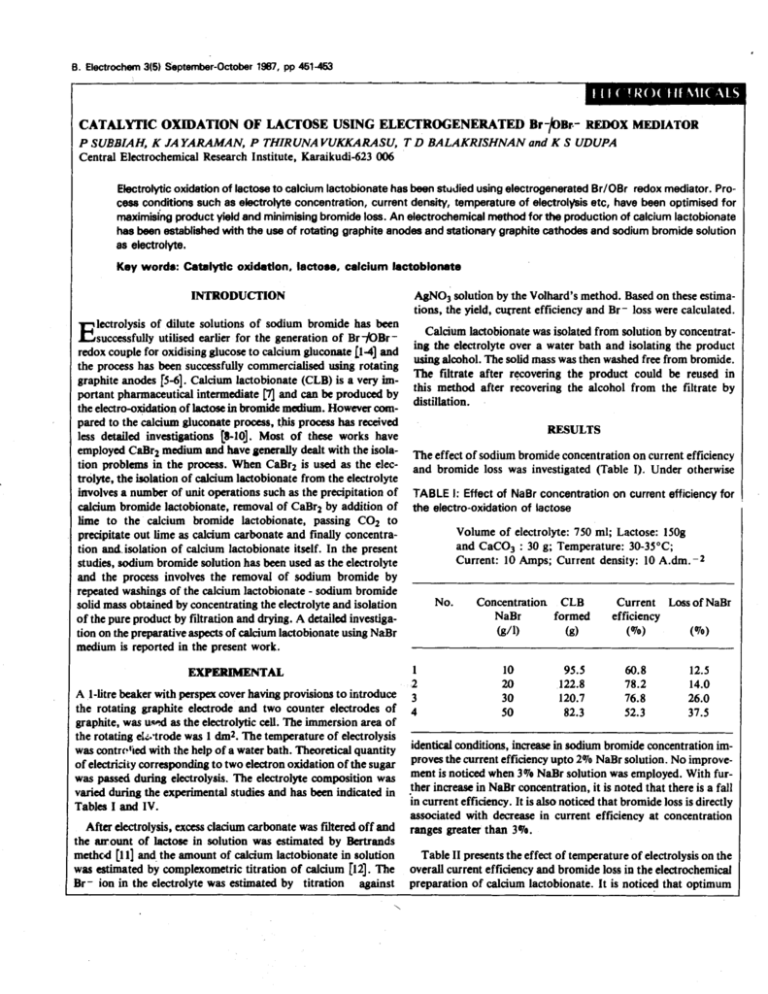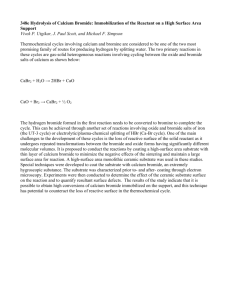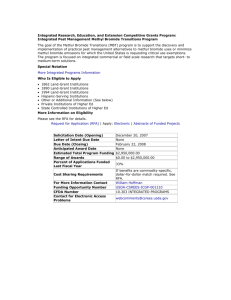Document
advertisement

6. Electrochem 36) September-October 1987, pp 461-463 CATALYTIC OXIDATION OF LACTOSE USING ELECTROGENERATED B~-/OB~.-REDOX MEDIATOR P SUPBIAH, K JA YARAMAN, P THIRUNA VUKKARASU, T D BALAKRISHNAN and K S UDUPA Central Electrochemical Research Institute, Karaikudi-623 006 Electrolytic oxidation of lactose to calcium lactobionate has been studied using electrogenerated BrIOBr redox mediator. Process conditions such as electrolyte concentration, current density, temperature of electrolysis etc, have been optimised for maximiskg product yield and minimising bromide loss. An electrochemical method for the production of calcium lactobionate has been established with the use of rotating graphite anodes and stationary graphite cathodes and sodium bromide solution as electrolyte. Key words: Catalytic oxidation, lactose, calcium hctobloru~te INTRODUCTION lectrolysis of dilute solutions of sodium bromide has been successfully utilised earlier for the generation of Br B B r E redox couple for oxidising glucose to calcium gluconate 11-41 and the process has been successfully comrnercialised using rotating ~raphiteanodes 15-61. Calcium lactobionate (CLB) is a very important pharmaceutical intermediate CI] and can be produced by the electro-oxidation of laaose in bromide m d u m . However a m pared to the calcium g l u c m t e process, this process has received less d d e d investigations [&lo]. Most of these works have employed CaBr2 medium and have generally dealt with the isolation problems in the process. When CaBr2 is used as the electrolyte, the isolation of calcium lactobionate from the electrolyte involves a number of unit operations such as the precipitation of calcium bromide lactobionate, removal of CaBr2 by addition of lime to the calcium bromide lactobionate, passing C02 to precipitate out lime as calcium carbonate and finally concentration and isolation of calcium lactobionate itself. In the present studies, sodium bromide solution has been used as the electrolyte and the process involves the removal of sodium bromide by repeated washings of the calcium lactobionate - sodium bromide solid mass obtained by concentrating the electrolyte and isolation >f the pure product by filtration and drying. A detailed investiga.ion on the preparative aspects of calcium lactobionate using NaBr nedium is reported in the present work. EXPERIMENTAL &NO3 solution by the Volhard's method. Based on these estimations, the yield, cqrent efficiency and Br- loss were calculated. Calcium lactobionate was isolated from solution by concentrating the electrolyte over a water bath and isolating the product using alcohol. The solid mass was then washed free from bromide. The filtrate after recovering the product could be reused in this method after recovering the alcohol from the filtrate by distillation. RESULTS The effect of sodium bromide concentration on current efficiency and bromide loss was investigated (Table I). Under otherwise TABLE I: Effect of NaBr concentration on current efficiency for the electro-oxidation of lactose Volume of electrolyte: 750 ml; Lactose: l5Og and CaC03 : 30 g; Temperature: 30-3S°C; Current: 10 Amps; Current density: 10 A.dm. -2 No. 1 2 3 Concentration CLB NaBr formed (B4 (g) 10 20 95.5 122.8 120.7 82.3 Current Loss of NaBr efficiency (W) 60.8 78.2 76.8 52.3 12.5 14.0 26.0 37.5 \ 1-litre beaker with perspex cover having provisions to introduce 30 be rotating graphite electrode and two counter electrodes of 4 50 graphite, was used as the electrolytic cell. The immersion area of he rotating eLtUvtrode was 1 dm2. The temperature of electrolysis vas contrcJied with the help of a water bath. Theoretical quantity identical conditions, increase in sodium bromide concentration im,f electridry corresponding to two electron oxidation of the sugar PFOVeS the current efficiency upto 2% NaBr solution. No improvevas passed during electrolysis. The electrolyte composition was ment is noticed when 3% NaBr solution was employed. With furraried during the experimental studies and has been indicated in ther increase in NaBr concentration, it is noted that there is a fall in current efficiency. It is also noticed that bromide loss is directly rables I and IV. associated with decrease in current efficiency at concentration After electrolysis, excess clacium carbonate was filtered off and ranges greater than 3%. he m o u n t of lactose in solution was estimated by Bertrands nethcd [l 11 and the amount of calcium lactobionate in solution Table I1 presents the effect of temperature of electrolysis on the ras estimated by complexometric titration of calcium [12]. The overall current efficiency and bromide loss in the electrochemical Lr- ion in the electrolyte was estimated by titration against preparation of calcium lactobionate. It is noticed that optimum - Catatytic oxidation of lactose using electrogenerated Br- OBr- redox mediator &&&ah et al ,-of t e m u r e on current efficiency and NaBr $&&~t: loat for the electro-oxidation of lactose TABLE IV: Effect of lactose concentration on current efficiency NaBr: I5 g (Other conditions same as in Table 111) NaBr concentration: 20 g/l; other conditions as in Table I No. No. lhperature CLB formed ("C) (lo NaBr at the Current Loss of end of efficiency NaBr electrolysis (B) Lactose concentration (g/l) CLB formed 150 88.1 Current effdenc; (s) - (%I 1 74.8 The effect of current density on the overall current efficiency and bromide loss in the electrochemical oxidation of lactose is presented in Table 111. It is seen from the results that decrease go TABEL Ill: Effect of current density on the current - and bromide loss for the electro-oxidation of lactose Tqpcrature : 35-40°C; Other conditions as in Table I1 No. Cumt density (A.b-2) r CLB NaBr at the Current Loss of formed, a d of efficiency NaBr electrolysis (B) (B) (qo) (070) Duntion of Etectrolpis (Amp. Hr.) Fig. 1: Variation of current efficiency with duration of electro1ysis during the oxidation of lactose current efficiency falls after 80% conversion of lactose to calcium lactobionate. It is further noticed that the current efficiency is around 80% and is nearly constant from the start of electrolysis upto 20 A-hrs in the total duration of 22 A.hrs. in current efficiency is associated with high bromide loss at higher current densities. It is also seen that the maximum current density a which current efficiency is high and bromide loss is low is 10 &p/dmz. , * ,CPICirra lactobionate is highly soluble in water and hence the can be recovered from the solution o d y by concentration. [tie bus desirable to build up as concentrated a solution as gossible during electrolysis. Experiments were carried out to investiwe he effect of lactose concentfation on the overall current efficien7,of the proc&.'The r@ts are presented in Table IY and it is m t f i a t the h m n t eff+hcy decreases above 200 g/l of lactose !mcamatlph. . s B. Electrochem 3(5) Sep-Oct 1987 DISCUSSION It has been reported from voltammetric studies [13] that lactose is not directly oxidized under the present experimental conditions. Bromide oxidation is the only process that takes place on the electrode surface and lactose is oxidized by the hypobrornite formed in the electrochemical step. It has also been established that the chemical reaction between the hypobromite and sugars is rather slow in the time scale of the voltammetric studies and the present work substantiates these findings, by the observation that higher temperatures are required for the preparative work. However, at higher temperatures (740°C), the current efficiency decreases due to Brz loss through evaporation. 'I$e finding thrd increase in Subbiah et al - Catalytic oxidation of lactose using electrogeneratbd Br- 1OBr- 1 redox mediator - NaBr concentration beyond 2% does not increase the current efficiency is also explained by the fact that the chemical reaction between OBr - and lactose is rather slow and the overall reaction rate cannot be pushed to higher levels by simply generating hypobr~mite faster. The decrease in current efficiency towards the end of electrolysis (Fig. 1) is due to the higher rate of generation of OBrand its lower rate of consumption with the depleted concentration of lactose towards the end of electrolysis. This may also result in the formation of bromate which can oxidize the sugar further. 4. H V K Udupa and B B Dey, Bull Central ElertmhemRes I N 5 (1956) 58 CONCLUSION 7. F J Prescott. J K Show, J P Bile110 and G 0 Cragwell, Ind Eng Chem, 45 (1953) 338 The present work on the oxidation of lactose in presence of sodium bromide solution as electrolyte establishes a route for the electrooxidation of lactose to calcium lactobionate at current efficiencies of the order of 80%. Optimum conditions of electrolysis have been established for high current efficiencies and low bromide losses. REFERENCES 5. H V K Udupa, G S Subramaniam, K S Udupa and T D Balakrishnan, Indian Pat. No. 147524 (1978) 6. K S Udupa and H V K Udupa in Technique of Electroorganic Synthesis Vol. V Part 111(Ed) N L Weinberg and B.V. Tilak, John Wiley and Sons (1982) p 412 8. H S Isbell, J Res Not1 Bur Stand, 11 (1933) 716 9. W M Corbett and J Kenner, J Chem Soc, (1953) 2245 10. M L Sengupta. N Bhattacharya and U P Baslr, Indian J Tech. S (1967) 152 1. C G Fink and D Summers Tram Electrochem Soc, 74 (1938) 625 11. B B Dey and M V Sitaraman, Lab. Manual of organic chemistry, 111 Edn. (1957) p 363 2. V Sarada Menon, H V K Udupa and B B Dey, Indian Pat. 51, 189 (1954) 12. A I Vogel, Text book of Quantitative Inorganic Analysis, I11 Edn. (1961) p 436 3. V Sarada Menon, H V K Udupa and B B Dey, J Sci Ind Res, 13B (1954) 746 13. P Subbiah, Ph.D. Thesis - Madurai Kamaraj (1986) REPORT ON THE SYMPOSIUM ON ELECTROCHEMICALS A three-day 'Symposium on Electrochemicals" was organised by Central Electrochemical Research Institute&ring 24th to 26th July at Karaikudi. Except one paper, the rest were all from India. The Symposium was inaugrated by Dr. S R Valluri and was presided over by Prof. K I V m . Prof. V m said that over 300 million kilowatt hours of energy had been saved for the caustic soda and chlorine industry in India alone as a result of the use of titanium substrate insoluble anodes. He said that electrochemicalprocesses developed at CECRI on potassium chlorate, perchlorates, calcium gluconate and camphor have been successfully cornmercialised. Research in such areas as conducting polymers, electropolymerisation and electrofluorination was presently being carried out. In his inaugural address, Dr. Valluri emphasized the need for development of electrochemical techylogy and cited its impact in the field of aeronautics and space apphcations. Prof. B K SadanandaRao, Professor of Chemical Engineering, I I T Bombay, released the Proceedings of the First National Conference on Electrochemicals ~ e l d j nAugust 1985. The Convenor of the Symposium and Head ~f EIectrochemicals Division, Mr. M Sundaram welcomed the gathering. Dr. K C Narasimham highlighted the scope of the sym,osium. Dr. K S Udupo proposed a vote of thanks. Eight plenary lectures and forty papers were presented in the ight technical sessions. More than 124) delegates attended the iymposium. The first session on 'Alkali-chlorine, water electrolysis etc.' was presided over by Dr. H V K Udupo. Three papers were presented. Dr. Udupa delivered a lecture on 'The trends in the manufacture of electrochemicals". In the first paper from E I Du Pont - Japan, the basic principles affecting the chloride transport through an ion exchange membrane was discussed so as to control the chloride present to 100 ppm in 50% commercial grade alkali. The next paper dealt with the use of diaphragms or membranes in the synthesis of electrochemicals. The last paper in this session was from CECRI in which computer simulation studies on the evaluation of various operating parameters of electrochemical processes have been reported. Dr. K S Rajagopalan chaired the technical session 2 on 'Chlorates, Perhalates and other inorganic chemicals'. During this session he delivered a lecture on "Industrial Electrochemistry, its ethos". In the first paper from I I T, Bombay, the influence of electrolyte circulation rate on the pseudo-mass transfer of hypochlorite in a chlorate cell in the absence of d i c h r k a t e was dealt with. The second paper was from CECRI on the simultaneous production of sodium perchlorate and zinc in a packed bed electrolyser, and the various process parameters were discussed. The next paper described the results of study on the electrolytic reduction of ferric to ferrous in titanic solution encountered during the manufacture of Ti02 pigment. Two other papers were on the preparation of sodium perborate from borax ;while the first paper described a direct method, the next made use of trickle bed reacB. Electrochem 3(5) Sep-Oct 1987 453







